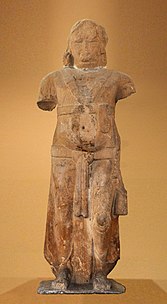
Back Yaksha Afrikaans যক্ষ Assamese Yaksa BJN যক্ষ Bengali/Bangla Ягшаа ба рагшас BXR Iaksa Catalan Iâ-chă CDO Jakša Czech Yaksha German Jakŝo Esperanto
Art of Mathura, Mathura Museum
The Yakshas (Sanskrit: यक्ष, IAST: Yakṣa, Pali: Yakkha) are a broad class of nature spirits, usually benevolent, but sometimes mischievous or capricious, connected with water, fertility, trees, the forest, treasure and wilderness.[4][5] They appear in Hindu, Jain and Buddhist texts, as well as ancient and medieval era temples of South Asia and Southeast Asia as guardian deities.[5][6] The feminine form of the word is IAST: Yakṣī[7] or Yakshini (Sanskrit: यक्षिणी, IAST: Yakṣiṇī; Pali: Yakkhini).[8]
In Hindu, Jain and Buddhist texts, the yakṣas have a dual personality. On the one hand, a yakṣa may be an inoffensive nature-fairy, associated with woods and mountains; but there is also a darker version of the yakṣa, which is a kind of (bhuta) that haunts the wilderness and waylays and devours travellers, similar to the rakṣasas.
- ^ a b Dated 100 BCE. Quintanilla, Sonya Rhie (2007). History of Early Stone Sculpture at Mathura: Ca. 150 BCE – 100 CE. BRILL. p. 368, fig. 88. ISBN 9789004155374.
- ^ Quintanilla, Sonya Rhie (2007). History of Early Stone Sculpture at Mathura: Ca. 150 BCE – 100 CE. BRILL. p. 365, fig. 85. ISBN 9789004155374.
- ^ Dalal, Roshen (2010). The Religions of India: A Concise Guide to Nine Major Faiths. Penguin Books India. p. 398. ISBN 978-0-14-341517-6.
- ^ Singh (2008). A History of Ancient and Early Medieval India. New Delhi: Pearson Education. p. 430. ISBN 978-81-317-1120-0.
- ^ a b Stefon, Matt. "Yaksha | Hindu mythology". Encyclopedia Britannica. Retrieved 15 July 2007.
- ^ Richard John Richards (1995). South-east Asian Ceramics: Thai, Vietnamese, and Khmer: From the Collection of the Art Gallery of South Australia. Oxford University Press. pp. 27, 67. ISBN 978-967-65-3075-2.
- ^ For यक्षी as the feminine of यक्षः see V. S. Apte, The Practical Sanskrit-English Dictionary, p. 776.
- ^ For yakṣiṇī (यक्षिणी) as a regular Sanskrit term for a female yakṣa, and yakṣaṇī as a Buddhist variant, see Franklin Edgerton, Buddhist Hybrid Sanskrit Grammar and Dictionary, Vol. 2, Motilal Banarsidass, first Ed., 1953, p. 442.

